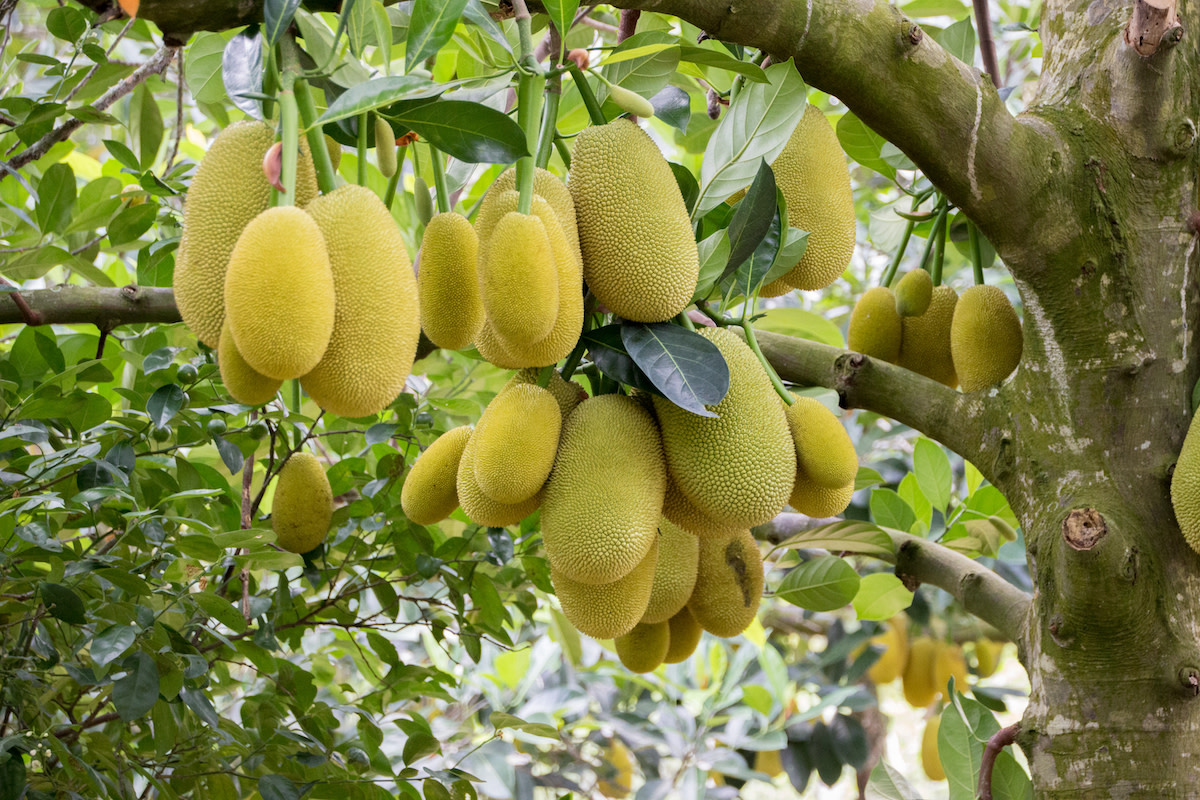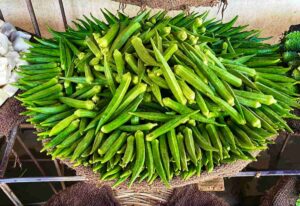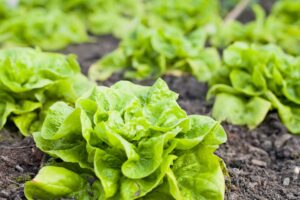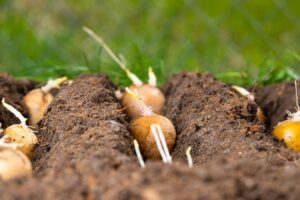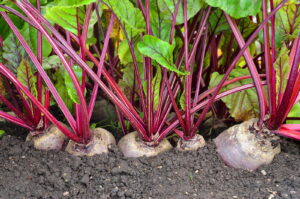How to Grow Jackfruit: A Complete Guide for Home Gardeners
Are you intrigued by the idea of growing your own jackfruit? This magnificent tropical fruit—the largest tree-borne fruit in the world—is gaining popularity in the United States for its versatility and unique flavor. Whether you have a spacious garden, a sunny patio for container growing, or just a bright indoor space, this guide will walk you through everything you need to know about growing jackfruit at home.
What is Jackfruit?
Jackfruit (Artocarpus heterophyllus) is a spectacular tropical fruit native to South Asia. It belongs to the mulberry family and is known for its impressive size—fruits can weigh between 10 and 100 pounds! In recent years, it has gained significant attention in the US market as a meat substitute due to its fibrous texture when young and as a delicious sweet fruit when ripe.
According to the USDA Agricultural Research Service, jackfruit is rich in nutrients including carbohydrates, proteins, vitamins, minerals, and phytochemicals, making it both a delicious and healthy addition to your diet.
Jackfruit Growing Conditions
Before diving into cultivation methods, it’s important to understand the ideal growing conditions for jackfruit:
Climate Requirements
Jackfruit thrives in tropical and subtropical climates. In the US, outdoor cultivation is generally limited to USDA hardiness zones 10-12, which include:
- Southern Florida
- Southern California
- Hawaii
- Puerto Rico
If you live outside these regions, don’t worry! You can still grow jackfruit in containers or indoors with proper care.
Soil and Light Requirements
For optimal growth, jackfruit trees need:
- Well-draining, loamy soil with pH between 6.0-7.5
- Full sun exposure (at least 6-8 hours of direct sunlight daily)
- Protection from strong winds
- Regular watering, especially during dry periods
Starting Jackfruit from Seeds
Growing jackfruit from seeds is the most common and economical method for home gardeners. Here’s a step-by-step guide:
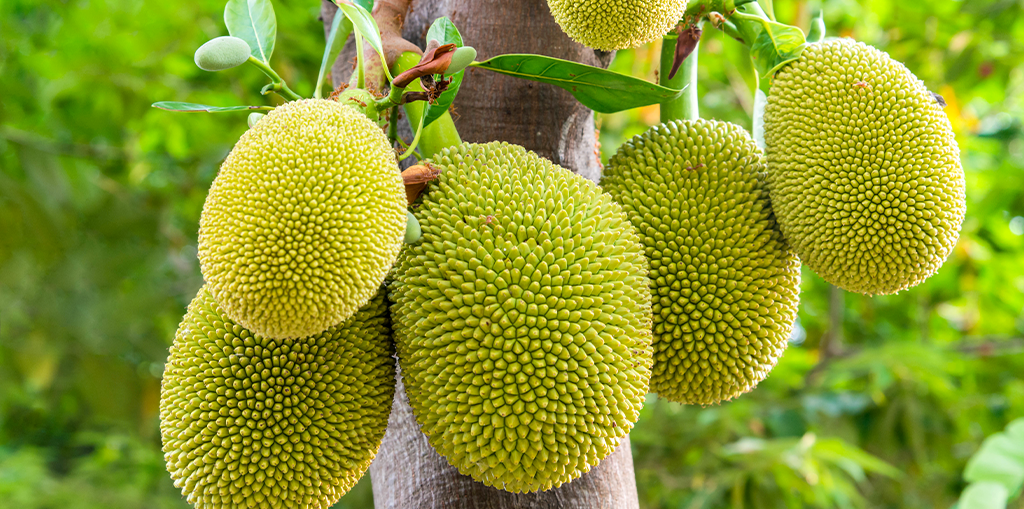
Selecting and Preparing Seeds
- Obtain fresh seeds: Purchase a ripe jackfruit from a specialty grocery store or farmers market. Fresh seeds have the highest germination rate.
- Extract seeds: Cut open the fruit, remove the fleshy bulbs, and extract the seeds.
- Clean the seeds: Wash thoroughly to remove any remaining fruit pulp.
- Prepare for planting: Soak the seeds in warm water for 24 hours to soften the seed coat and encourage germination.
Planting Jackfruit Seeds
- Prepare the growing medium: Use a mixture of potting soil, compost, and sand (2:1:1 ratio).
- Plant the seeds: Place seeds about 1 inch deep in individual pots, with the broader end facing downward.
- Water thoroughly: Keep the soil consistently moist but not waterlogged.
- Provide warmth: Maintain temperatures between 70-85°F (21-29°C).
- Wait for germination: Seeds typically sprout within 3-8 weeks.
Growing Jackfruit in Garden Soil
If you live in a suitable climate zone, growing jackfruit directly in your garden can lead to impressive results:
Site Selection and Preparation
- Choose the right location: Select a spot with full sun exposure and protection from strong winds.
- Prepare the soil: Dig a hole approximately 3 feet wide and 3 feet deep.
- Improve drainage: Add organic matter like compost and some sand to improve soil structure.
- Space properly: Allow at least 30-40 feet between trees as mature jackfruit trees can grow quite large.
Planting in Garden Soil
- Transplant seedlings: When seedlings reach 12-18 inches tall with several true leaves, they’re ready to transplant.
- Plant carefully: Place the seedling in the prepared hole, keeping the root ball intact.
- Backfill: Fill the hole with soil mixture, tamping gently to remove air pockets.
- Water thoroughly: Give a deep initial watering to help the roots establish.
- Mulch: Apply 2-3 inches of organic mulch around the base, keeping it away from the trunk.
Container Growing for Jackfruit
Don’t have garden space or live in a colder climate? Container growing might be your best option:
Choosing the Right Container
- Size matters: Start with a 10-15 gallon pot for young trees, with plans to upgrade as the tree grows.
- Material: Terracotta or fabric pots work well as they allow good air circulation.
- Drainage: Ensure the container has multiple drainage holes.
Container Planting Process
- Prepare the container: Add a layer of gravel at the bottom for drainage.
- Use quality soil: Fill with high-quality potting mix enriched with compost.
- Plant properly: Position the seedling at the same depth it was growing previously.
- Water and place: Water thoroughly and position in a sunny, protected area.
Special Care for Container-Grown Jackfruit
- Regular watering: Container plants dry out faster than garden plants.
- Frequent feeding: Apply a balanced fertilizer monthly during the growing season.
- Root management: Repot every 2-3 years to prevent root binding.
- Winter protection: Move containers indoors or to a protected area if temperatures drop below 40°F (4°C).
Growing Jackfruit Indoors
Yes, it’s possible to grow jackfruit indoors, though the trees will remain smaller and may not produce fruit as readily:
Indoor Growing Requirements
- Light: Place near a south-facing window or use grow lights for 12-14 hours daily.
- Temperature: Maintain 65-85°F (18-29°C).
- Humidity: Provide 60-80% humidity using a humidifier or pebble tray with water.
- Air circulation: Ensure good airflow to prevent fungal issues.
Indoor Growing Tips
- Start small: Begin with dwarf varieties if available.
- Pollination: Hand-pollinate flowers using a small brush if flowers develop.
- Pruning: Regular pruning will help maintain a manageable size.
- Pest management: Inspect regularly for common houseplant pests like spider mites and mealybugs.
Jackfruit Care and Maintenance
Regardless of where you grow your jackfruit, proper care is essential:
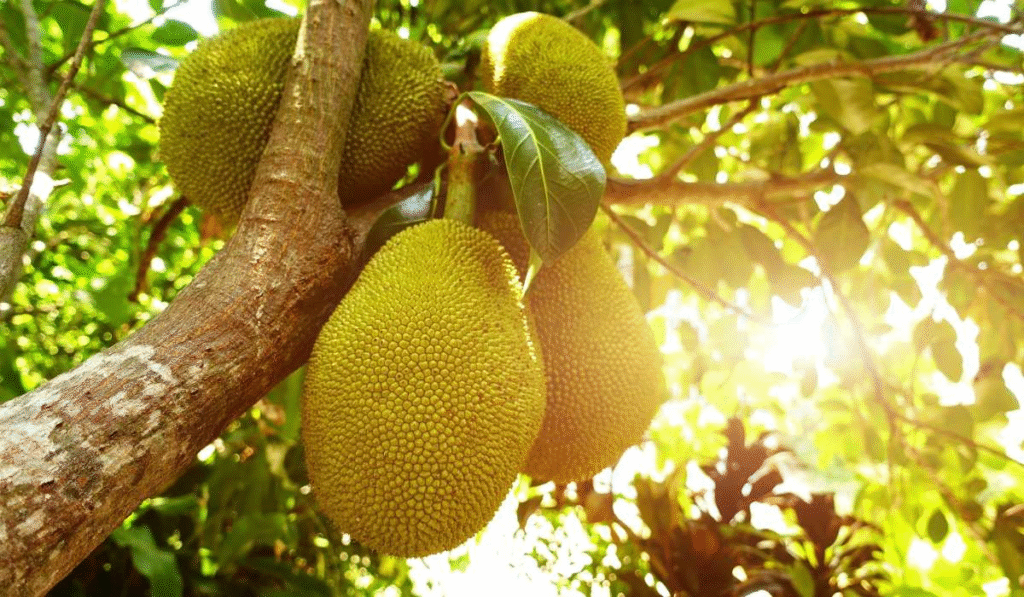
Watering Schedule
Water requirements vary based on growing conditions:
| Growth Stage | Garden Plants | Container Plants | Indoor Plants |
|---|---|---|---|
| Seedlings | Every 2-3 days | Daily | Every 1-2 days |
| Young Trees | Weekly | Every 2-3 days | Every 3-4 days |
| Mature Trees | When soil dries out | When top inch is dry | When top inch is dry |
| Fruiting Period | Increase frequency | Increase frequency | Increase frequency |
Fertilization
- Young trees: Apply a balanced fertilizer (like 10-10-10) every 2-3 months.
- Mature trees: Switch to a fertilizer higher in potassium and phosphorus (like 8-3-9) during fruiting.
- Application rate: Follow package instructions, but generally apply 1 pound per year of tree age, up to a maximum of 15 pounds.
Pruning and Training
- Formative pruning: Shape young trees by removing lower branches and establishing a central leader.
- Maintenance pruning: Remove dead, diseased, or crossing branches annually.
- Size control: For container and indoor plants, prune regularly to maintain desired size.
Common Challenges and Solutions
Pests and Diseases
- Fruit flies: Cover developing fruits with protective bags.
- Scale insects: Apply horticultural oil or insecticidal soap.
- Root rot: Ensure proper drainage and avoid overwatering.
- Powdery mildew: Improve air circulation and apply fungicide if necessary.
Environmental Issues
- Cold damage: Protect young trees with frost cloth when temperatures drop below 40°F (4°C).
- Sunscald: Gradually acclimate indoor plants to outdoor sun exposure.
- Nutritional deficiencies: Yellowing leaves often indicate nitrogen deficiency; apply appropriate fertilizer.
Harvesting Your Jackfruit
Patience is key—jackfruit trees typically take 3-8 years to bear fruit:
When to Harvest
- Color change: Fruits change from green to yellow-brown when ripening.
- Sound test: Ripe fruits produce a hollow sound when tapped.
- Aroma: A sweet, fruity smell indicates ripeness.
Harvesting Process
- Wear gloves: The sticky latex can be difficult to remove from skin.
- Use sharp tools: A clean, sharp knife or pruners work best.
- Leave a stem: Cut about 1-2 inches of stem attached to the fruit.
- Handle with care: Despite their size, jackfruits bruise easily.
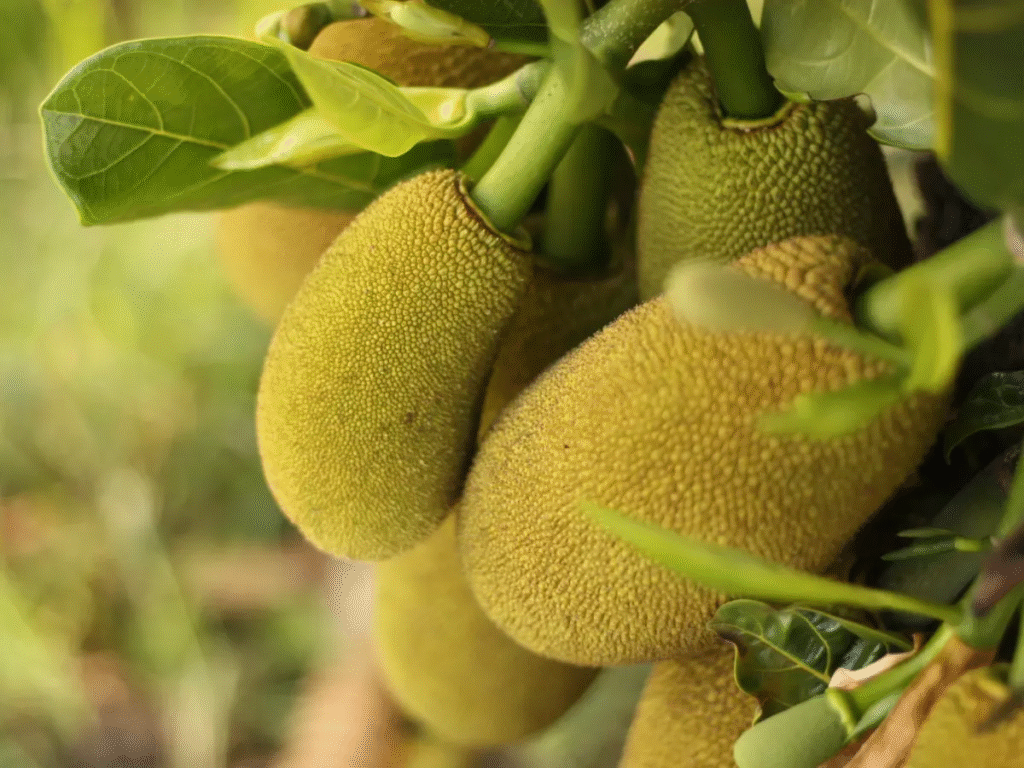
Jackfruit in the US Market
The jackfruit market in the United States has grown significantly in recent years:
Market Trends
- Increased demand as a plant-based meat alternative
- Growing presence in mainstream grocery stores
- Rising popularity in vegan and vegetarian cooking
- Expansion of processed jackfruit products (canned, frozen, dried)
Growing for Market
If you’re considering growing jackfruit commercially in suitable US regions:
- Varieties: Focus on varieties with consistent quality and yield.
- Post-harvest handling: Develop proper storage and transportation methods.
- Market connections: Establish relationships with specialty grocers, restaurants, and food manufacturers.
- Value-added products: Consider processing options to extend shelf life and increase marketability.
Conclusion
Growing jackfruit at home—whether in your garden, in containers, or indoors—can be a rewarding experience. While it requires patience and attention to specific growing conditions, the result is a spectacular tree that produces nutritious, versatile fruits that are increasingly valued in American cuisine.
By following the guidelines in this article, you’ll be well on your way to growing your own jackfruit, even if you don’t live in a tropical climate. Remember that experimentation is part of the gardening journey, so don’t be afraid to adapt these recommendations to your specific conditions.
